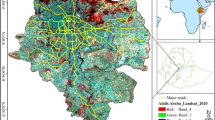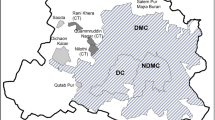Abstract
Why do some places evolve into large sprawling metropolitan settlements over time, while other initially similar sites decay into obscurity? Identifying the factors underlying the phenomenon of urban growth has sparked the curiosity of scientists ever since Walter Christaller proposed the Central Place Theory in order to explain the observed number, sizes and locations of settlements in southern Germany. However, lack of availability of sufficient empirical data has hampered progress in developing a quantitative understanding of this process. In order to initiate a data-driven approach to answer questions on the growth of settlements, we have undertaken the analysis of a large database of economic, demographic and infrastructural factors associated with different sites of habitation in India. Here we present preliminary results of our analysis for a few of the most populous states of the Indian Union, viz., Maharasthra, Tamil Nadu and Uttar Pradesh. As rapid urbanization taking place in many parts of the country provides a window into the fast-changing rural-urban landscape, we have investigated the growth/decay of population centers in these states using information gleaned from government census reports. In particular, we show that combining demographic data with geographical information allows the identification of specific locations as being either growth “hot-spots” and decay “cold-spots”. In addition, we compare the process of growth in different states (which have distinct trajectories for the evolution of the total population size) across multiple scales of settlement sizes. We also show that, for all the states considered here, the nature of the population distribution at different scales (of settlement sizes) appear to change from a sharply bounded to a long-tailed one as one considers larger settlement size scales, implying that distinct population growth processes are at work in different scales.
Access this chapter
Tax calculation will be finalised at checkout
Purchases are for personal use only
Similar content being viewed by others
References
W. Christaller, Central Places in Southern Germany(Prentice-Hall, 1966)
G. Zipf, Human Behaviour and the Principle of Least Effort (Addison-Wesley, Cambridge, 1949)
R. Gibrat, Une loi des rparations conomiques: leffet proportionnel. Bull. Stat. Gen. Fr. 19, 469 (1930)
M. Kalecki, On the Gibrat distribution. Econom.: J. Econom. Soc. 13, 161–170 (1945)
J. Eeckhout, Gibrat’s law for (All) cities. Am. Econ. Rev. 94, 1429–1451 (2004)
R. Gonzlez-Val, L. Lanaspa, F. Sanz, In Gibrat’s law for cities revisted (2010), http://www.eefs.eu/conf/athens/Papers/503.pdf
Y. Sasaki, H. Kuninaka, N. Kobayashi, M. Matsushita, Characteristics of population distributions in municipalities. J. Phys. Soc. Jpn. 76, 074801-6 (2007)
Acknowledgments
Authors will like to thank the team at Scimergent Analytics who helped organize the census and latitude-longitude data. We would also like to thank Dr T. Jesan and Dr Arnab Chatterjee for helpful discussions.
Author information
Authors and Affiliations
Corresponding author
Editor information
Editors and Affiliations
Rights and permissions
Copyright information
© 2015 Springer International Publishing Switzerland
About this chapter
Cite this chapter
Sridhar, S., Thiagarajan, T., Sinha, S. (2015). Spatio-Temporal Patterns of Development in India: Identifying Geographical Features of Growth and Urbanisation. In: Abergel, F., Aoyama, H., Chakrabarti, B., Chakraborti, A., Ghosh, A. (eds) Econophysics and Data Driven Modelling of Market Dynamics. New Economic Windows. Springer, Cham. https://doi.org/10.1007/978-3-319-08473-2_10
Download citation
DOI: https://doi.org/10.1007/978-3-319-08473-2_10
Published:
Publisher Name: Springer, Cham
Print ISBN: 978-3-319-08472-5
Online ISBN: 978-3-319-08473-2
eBook Packages: Physics and AstronomyPhysics and Astronomy (R0)




